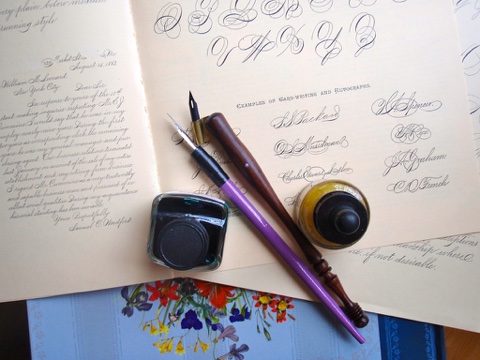 However, you can’t just grab any old pen from the office supply store. Using the right tools from the get-go will give you results you are eager to show off! The pen nib and holder used for this lettering is fairly uncommon, and therefore requires an introduction.
However, you can’t just grab any old pen from the office supply store. Using the right tools from the get-go will give you results you are eager to show off! The pen nib and holder used for this lettering is fairly uncommon, and therefore requires an introduction.
Let’s review must-have pointed-pen calligraphy supplies for beginners.
1. Pointed pen nib
 A pen nib is the metal tip of the pen that holds your ink. As a beginner, it’s good idea to look for a large, stiff pen nib, which makes it easier to control while practicing this delicate art. Avoid the very teeny tiny nibs! Those are considered advanced, and you can give those a try once you’ve mastered the techniques.
I find that the Nikko Comic Pen Nib – G is great for beginners. It has all the qualities listed above, and is relatively easy to find online and in art supply stores. If you can’t find this nib, pick another large, stiff nib, like the Hunt 104 or Brause 511.
A pen nib is the metal tip of the pen that holds your ink. As a beginner, it’s good idea to look for a large, stiff pen nib, which makes it easier to control while practicing this delicate art. Avoid the very teeny tiny nibs! Those are considered advanced, and you can give those a try once you’ve mastered the techniques.
I find that the Nikko Comic Pen Nib – G is great for beginners. It has all the qualities listed above, and is relatively easy to find online and in art supply stores. If you can’t find this nib, pick another large, stiff nib, like the Hunt 104 or Brause 511.
2. Pen holder
 Of course, you’ll need something to hold the pen nib, and that’s where pen holders come into place. You have a few options:
Of course, you’ll need something to hold the pen nib, and that’s where pen holders come into place. You have a few options:
- You can choose a straight or oblique holder
- You can choose a plastic or wood holder
3. Ink
When starting out, look for an ink that flows nicely and has a rich, black color (you can have fun with colors later!). I recommend Higgins Eternal Ink, which is easy to find. Some beginners may find this too watery at first. If that’s the case, just leave the ink top off for about a day so that some of the water can evaporate.4. Paper
Paper is very important to the calligrapher! A high-quality, smooth paper will make all the difference in smooth, confident writing. That doesn’t mean you have to invest heavily in fancy stationery. Sometimes, depending on your country and paper availability, even regular lined school paper or some brands of blank computer paper can work for practice with the pointed pen. But beware of papers marketed as “calligraphy practice pads” — sometimes these are no good. If you want to use paper that’s a little nicer, Bristol drawing paper tends to be a reliable choice. I also like “bond” paper, or paper that has a cotton content. Just be sure there is no “tooth” or texture to the paper, which can be very frustrating as the paper can become caught in between the tines of the pen nib. Really, there’s no right or wrong! Try out many different types of paper and paper pads, as there is great variation in quality.More materials you might want to try
The four tools listed above are really all you need to get started. However, if you want to expand your toolkit, I recommend the tools below, which I used while filming my modern pointed pen calligraphy class.- Turned wood pen holder
- Moon Palace Sumi Ink
- 24 lb. bond paper practice pad, 8½” x 11″ (specifically, 24lb bond paper)
- Strathmore lined writing pad
- Strathmore writing envelopes
- Dappen dish for decanting ink (it is so dry in Colorado that I needed to add extra water to my ink to keep it flowing nicely! To do this, I poured a bit of ink in the dappen dish and add drops of water until it was just right.)

Just started Weaver Writing
I am a beginner and I prefer markers to pens. Do you have any suggestions? I am overwhelmed. Thanks.